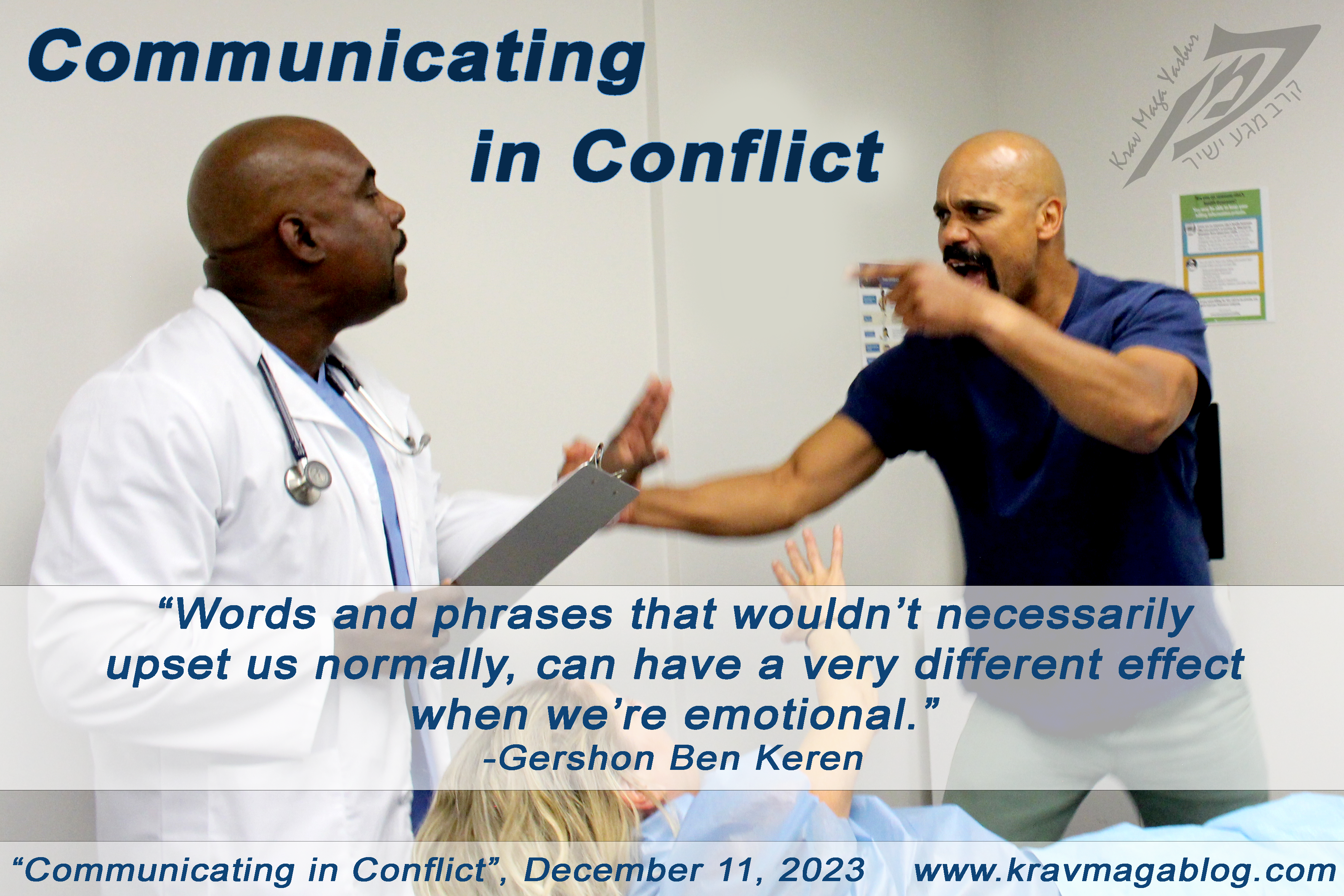Author: Gershon Ben Keren

When we are trying to communicate to resolve a conflict, we need to ensure that the other person is receptive to what we are saying. At the same time, we need to demonstrate that we are also willing and receptive to hearing what they have to say. However, if we use the same methods and linguistic tools that we do when dealing with and discussing “facts” we are likely to be unsuccessful in accomplishing this. When dealing with a person who is emotional because they are angry, frustrated and/or upset, they aren’t often ready to take a look at the “facts”, they may also in that moment have a very different idea as to what the “facts” actually are. To develop conversational receptiveness, we are likely to have to rephrase some of our everyday language and responses, and avoid using certain “trigger” words, or substitute them for others. In this article I want to look at how we can do some of these things in order to prevent an interaction from escalating and set the foundations for de-escalation and eventual conflict resolution.
When dealing with angry and emotional people we may want to set boundaries and express how we want the communication exchange to be conducted. This is to prevent “entry(way) behaviors” from potentially developing into more serious ones, such as veiled and then overt threats, which a person may then not be able to walk back. Sometimes when a person has escalated to making threats, they have crossed a line that they don’t know how to get back to the other side of. It is similar to when angry and scared people draw knives and other weapons; they find it almost impossible to put the weapon away even when the threat or danger has passed. This is why when training emergency room staff in de-escalation and conflict management, I teach addressing behaviors such as shouting and swearing, as if left alone they appear as permissible behaviors to the person engaged in them. There is always a fear that engaging with such individuals makes things worse, but the truth is that not saying anything allows for the person to engage in further, escalating behaviors. In the early stages of a conflict/disagreement when a person may not yet be in a volatile state setting the terms for the interaction at the outset can prevent things from escalating. It may be that every time you go to speak the other person cuts you off and talks over you, and this is something you need to change in order to stop the conflict from escalating further. If this isn’t addressed it may set the tone of the conversation and be interpreted as a “power move” on the other person’s part i.e., they get to talk and express their opinion you don’t. A natural response when someone is doing this is to express your frustration by saying something like, “I hate it when people cut me off, and talk over me!” However, by expressing your frustration in this way, you are telling the other person not to do something, which can be interpreted as posturing. By reframing your response to this issue by saying, “I really appreciate it when people let me finish what I’m trying to say.”, you are far more likely to encourage the other party to change their behavior.
Just like changing negative statements into positive ones, there are certain words which people either react badly to and/or have alternatives that are more effective in instigating change in someone’s behavior. It has been found that in crisis situations substituting “speak” for “talk” is more likely to be effective in developing rapport. There may seem little difference between the two questions, “Can we talk?”, “Can we speak?” Despite the word speak generally being seen as a more “formal” word than talk, speak focuses on the speaker, rather than on the process of talking/communication. In many situations where someone has become angry due to frustration, being acknowledged is an important part of the de-escalation process, and focusing on the speaker helps accomplish this. Using the word “help”, in sentences such as, “I’m trying to help you here” should be avoided, as it implies a power differential, with one party requiring assistance from the other. However, it can also be used to help balance what may be perceived as a power-differential, such as in a request like, “Can you help me understand what’s making you angry?” etc. There are also trigger words that can automatically escalate a situation. Using words such as “obviously” and “clearly” e.g., “Obviously/clearly, what has happened here is…”, “It’s obvious/clear what needs to be done here.”, are likely to increase the emotions of the other person. The inference is that the person making the statement understands what has happened and/or needs to be done, and to offer a different explanation and/or solution, would be to admit to not understanding what is going on and to being stupid. Starting sentences with the word “obviously”, also has a note of finality to the interaction, when the other party may still be processing what has happened/is happening. Whilst something may appear obvious/clear to you, it doesn’t necessarily mean it objectively is, and/or the other person is ready to accept that.
Whilst substituting certain words for others, and avoiding the use of certain words at all, may seem trivial, this is only because we are thinking about their use whilst we are in a calm and rational state. Words and phrases that wouldn’t necessarily upset us normally, can have a very different effect when we’re emotional. Thinking about these things before we are in a verbal conflict with someone, and even developing “scripts” that avoid them, will see us better prepared to deal with angry and emotionally volatile people.